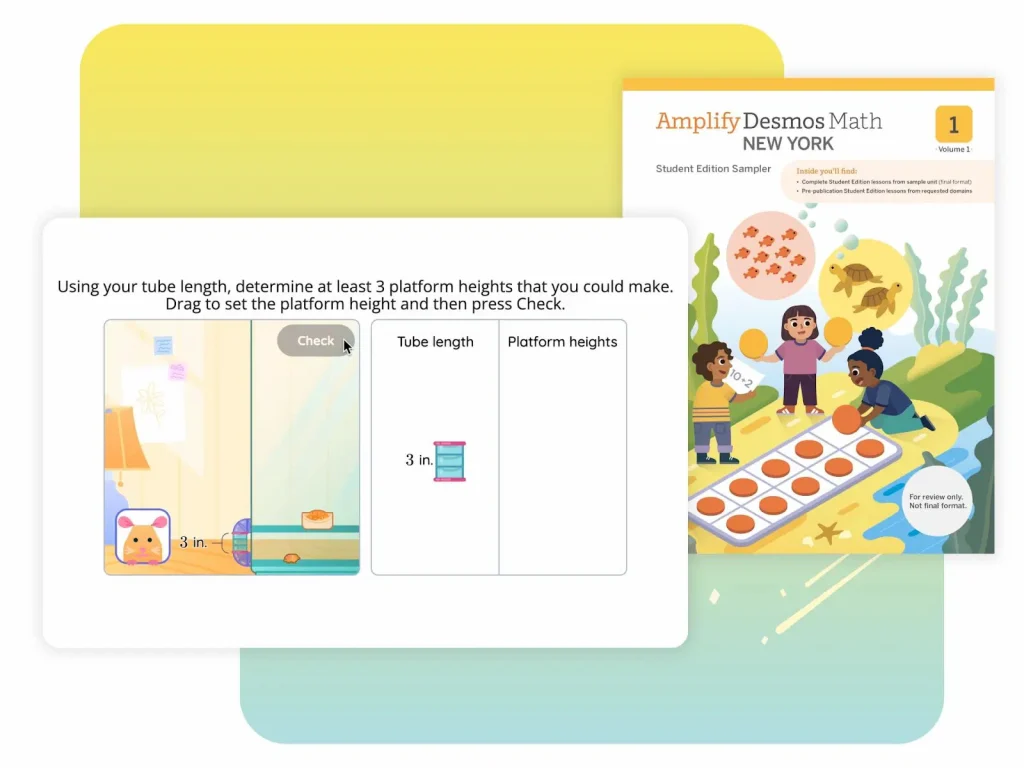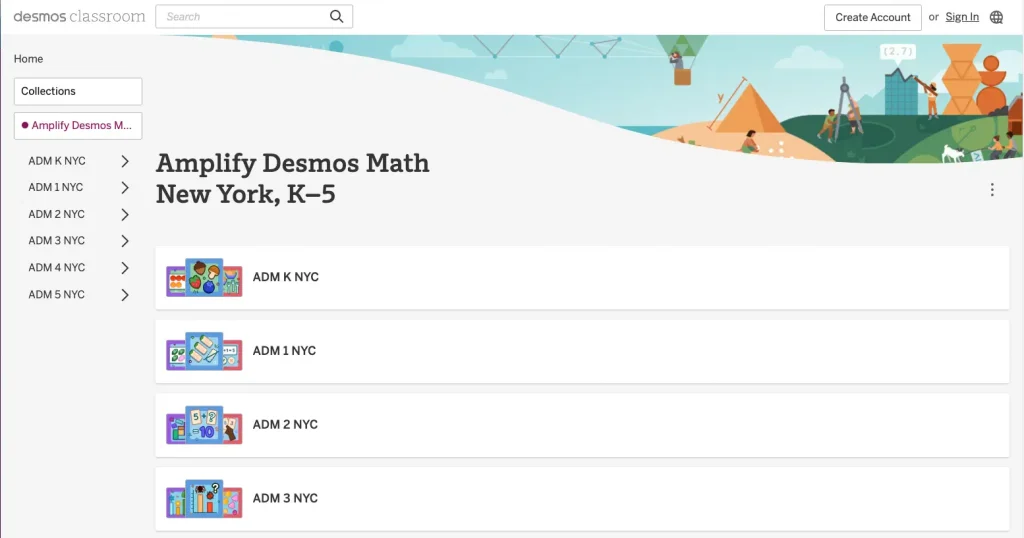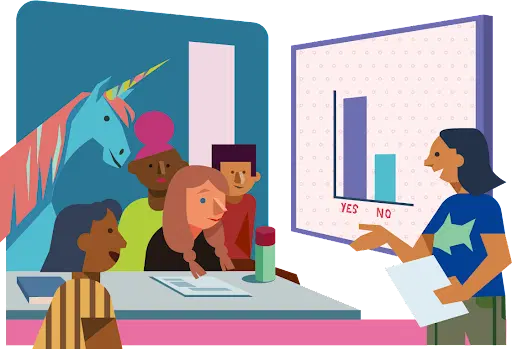Families & Caregivers — Welcome to Amplify Desmos Math New York for grades K–5!
This is the initial version of the Caregiver Hub for Amplify Desmos Math New York. Para la versión en español, haga clic aquí.
Welcome to the Amplify Desmos Math New York K–5 Caregiver Hub for grades K–5. We’re so excited your student’s school has chosen our program! We designed this space to help you support your student in their math journey this year. Your hard work plays an essential role in your student’s math experience.
We hope your student enjoys using technology to explore math, working with friends to solve problems, and learning all sorts of new and interesting concepts. And we hope you love experiencing it with them!
Excited to learn together,
—The Amplify Desmos Math team

Introducing Amplify Desmos Math
Amplify Desmos Math is a core math curriculum built for kindergarten through grade 5. We developed the program around the idea that a structured approach to problem-based learning builds on students’ curiosity to develop lasting grade-level understandings for all students. Each lesson offers opportunities to develop students’ understanding; connect their ideas; grow their skill fluency; and empower them to ask questions, explore, and make discoveries.
Amplify Desmos Math uses a student-centered approach to instruction, which has been proven to significantly increase math learning. Our mission is for your students to learn math—and to love learning math!
In every lesson, the Amplify Desmos Math curriculum poses engaging and relevant problems to solve, giving students daily opportunities to think critically, work collaboratively, and actively participate in their own learning.

About student-centered math instruction
Student-centered instruction may look different from the way students have learned math in the past, and perhaps from the way you learned math. Instead of memorizing formulas and tricks, student-centered learning focuses on giving students opportunities to figure out how math works. Research shows that students and teachers alike prefer this method, and teachers report that student-centered instruction has helped their students learn more math.

This way of learning helps students:
- Understand how math concepts work.
- Remember what they learn in class and apply their knowledge to new situations.
- Perform better on standardized tests and have more growth in their grades than their peers who learn through other methods.
- Learn to communicate in writing and verbally, understand and challenge the opinions of others, and build confidence in solving new problems.
- Develop key skills for success in college and the workplace, like using technology, completing projects independently and with others, and persevering through difficult problems.
What materials do students use?
Amplify Desmos Math supports blended learning with supportive print materials and a unique digital experience. All Amplify Desmos Math K–5 lessons are available in a write-in Student Edition book. Many of the lessons are designed to include hands-on activities with manipulatives. An age-appropriate number of lessons are designed for students to use digital devices like laptops or tablets. These include enhanced digital experiences that teachers can assign to students.

Here’s what you can expect for your students from Amplify Desmos Math:
- Lessons that drive classroom discussions so students can work toward a shared understanding and sense of community.
- Responsive feedback that interprets student responses in context and encourages perseverance and revision.
- Easy-to-follow lesson plans tested in classrooms across the country, with clear teaching suggestions, strategies, and Math Language Routines.
- Practice problems to support fluency and help students review previous topics.
- Recommended differentiation suggestions for teachers so that they can meet the needs of diverse learners.
- Formative assessments that provide information on student understanding so that they can adjust their instruction to meet the needs of all students in their class.
- Summative assessments that help teachers understand what students know about the math content they have been learning.
- Daily lesson-level assessments so that teachers can frequently check for understanding.
- A caregiver resource for each unit that includes explanations of key math concepts and problems to try with your student.
When students use devices, teachers can monitor students’ work in real time, making sure they get the exact support that they need at every part of the lesson, in and outside of class. Here is a sample of what a teacher sees on their dashboard to help them monitor thinking and support student learning.

Students are also able to access their digital work at home. Here’s an article on how to navigate the student home page.
What does a lesson look like?
Students in an Amplify Desmos Math classroom can be seen (and heard!)—asking questions, debating answers, justifying their thinking, grappling with problems, and working together and independently.

Here’s what a typical Amplify Desmos Math lesson includes:
- Warm-up: A short, attention-getting problem to get students interested in the lesson.
- Activities: 1-2 mini-activities that challenge students’ problem-solving skills.
- Synthesis: Discussion to review and bring together the important concepts from the lesson.
- Show What You Know and Reflection: Questions for students to show what they know from the lesson. (Note: The “Show What You Know” lesson assessment is optional for the teacher to assign in kindergarten and grade 1)
- Centers: Student-led activity stations that reinforce the math learned during lesson activities through interactive and often game-like formats. In kindergarten and grade 1, time for Centers is built into the last 15 minutes of every lesson.
Here’s what is available after the lesson to support, strengthen, and stretch students’ learning:
- Differentiation: Mini-lessons, Centers, extensions, personalized learning, and fluency practice.
- Practice: Additional problems your student’s teacher may assign for classwork or homework.
How can caregivers support math learning at home?
Use our Unit Support for Caregivers
We’ve created a Caregiver Resource for every unit of the program that provides a summary of key concepts, plus a problem from the lesson practice set you can work through with your student. Within each of the grade-level links below, you’ll find a Caregiver Resource document for each unit, in both English and Spanish.
Grade 1
Unit 1: Adding, Subtracting, and Working With Data
English
Spanish
Grade 3
Unit 1: Introducing Multiplication
English
Spanish
Grade 5
Unit 1: Volume
English
Spanish
Review practice problems together
Your student’s teacher may assign practice problems at the end of each lesson for classwork or homework. If your student has already completed the practice problems for the lesson, ask your student to walk you through how they solved each problem, or talk about any parts that were challenging for them. Ask your students follow-up questions to encourage the use of math language as they explain their thinking, such as: “How do you know?,” “How can you show your thinking?,” or “How would you describe that?” If students are stuck, ask support questions such as, “What information do you know here?” or “How could you represent this problem?”
Getting stuck is okay!
Emphasize that getting stuck is part of the process and a necessary part of learning. Many students (and adults!) fear making mistakes. However, research shows that making mistakes helps your brain grow more. When your student gets stuck on a problem, encourage them to try different strategies, even if they are not sure if they are right.
Find the math in everyday life.
Relate math to daily activities at home, whether grocery shopping, preparing a meal, or planning for a trip to the store. Your student can help you figure out how many more apples there are than oranges in the grocery cart, show how to split a sandwich into fourths, or figure out how much change you’ll receive in exchange for a ten dollar bill. Encourage your student to point out ways that you use math in daily tasks.
Read the Unit Story with your student.
Each unit in Amplify Desmos Math K–5 begins with a read-aloud story to engage students and provide context for the math of the unit. Elements and characters from the Unit Story then appear in lessons throughout the rest of the unit.
Grade K Unit 2 Story
Grade 1 Unit 1 Story
Grade 2 Unit 1 Story
Grade 3 Unit 1 Story
Grade 4 Unit 1 Story
Grade 5 Unit 1 Story
Access our Featured Collection of free K–5 Lessons and Activities.
Explore our latest free K–5 content in our Desmos Classroom Featured Collection. With our free collection, you can access:
- Digital Lessons: Engaging interactive lessons
- Mini-Lessons: A mix of print and digital activities designed for small-group instruction
- Math Routines: Short digital activities to kick-start instruction and encourage math discussions
- Bite-Sized Math Moments: Digital practice activities that use Polypad virtual manipulatives, designed to be used flexibly
Click here to access the collection and sign up for a free account.
How do caregivers access the program at home?
Your student will have access to all learning, practice, and assessment materials through the Amplify platform. Students can access the digital curriculum in school and at home by following these simple instructions.
- Click the orange Login to Amplify Desmos Math button below.
- Select Log in with Amplify.
- Enter your student’s username and password provided by your student’s teacher.
- Select your student’s grade level.